Shipping container cabins have emerged as a popular and sustainable choice for those looking for a cost-effective and eco-friendly alternative to traditional cabin construction. These structures are crafted from repurposed shipping containers, which were originally designed for transporting goods across the globe. Their inherent strength, durability, and modularity make shipping containers apt for conversion into habitable spaces, particularly cabins which can serve as compact homes or as retreats for leisure activities like hunting.
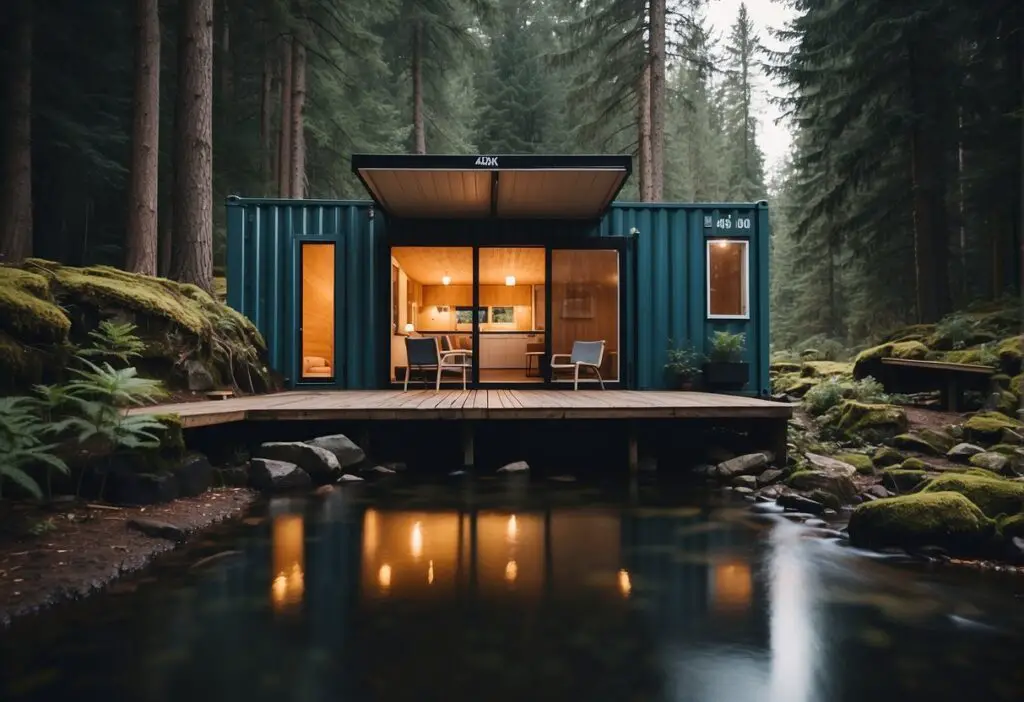
The concept of transforming a shipping container into a livable cabin involves various customizations to meet the owner’s needs. These alterations might include insulation, installation of windows and doors, and the addition of utilities to create a comfortable and functional space. The flexibility in design allows potential owners to craft everything from cozy, minimalist retreats to larger, more elaborate container homes. This adaptability, coupled with the containers’ robustness, makes them suitable for a wide range of climates and locations, from remote woodland areas to residential backyards.
Interest in container homes is fueled by their cost-effectiveness and the relatively short time frame required for conversion compared to traditional building methods. The process begins with selecting the right container size and condition, followed by planning the desired layout and custom features that one may want to incorporate. Companies specializing in shipping container modifications provide services to assist with this process, offering expertise in how best to bring these unique cabin concepts to life whilst ensuring that they are both functional and compliant with building codes.
Understanding Shipping Container Cabins
Shipping container cabins present a unique amalgamation of sustainability and practicality. As eco-friendly alternatives to traditional structures, these cabins have repurposed the robust architecture of shipping containers to create innovative living spaces.
History and Evolution
Shipping containers have experienced a remarkable transition from simple corrugated boxes for transport to the foundations of modern architecture. The inception of shipping container cabins can be traced back to their accessibility, durability, and the rising interest in sustainable living. The idea took hold as both architects and individuals realized that these steel structures could easily be converted into functional spaces. They have become popular as tiny homes, hunting cabins, and even elaborate residences, mirroring the growing trend of minimalist and eco-friendly living solutions.
Types and Uses
- Basic Cabins: Simple units with minimal modifications, often used as rustic retreats or hunting cabins.
- Luxury Cabins: Highly customized containers with amenities akin to traditional homes, suitable for permanent residence.
- Mobile Offices: Adaptable and transportable units designed for temporary workspace needs.
- Emergency Shelters: Quickly deployed dwellings for use in disaster relief scenarios.
Each type of shipping container cabin serves a specific purpose, from offering a retreat in nature to providing an emergency homestead. The evolution of these cabins has proven that shipping containers have a place beyond the confines of global trade, reinforcing their position as a cornerstone in the movement towards innovative and sustainable architecture.
Design and Planning
Designing and planning are critical steps when embarking on a project to build a shipping container cabin. These stages involve considering the dimensions of the container, mapping out the interior space, and ensuring the structure is well-insulated for comfort.
Selecting the Right Size
Shipping containers come in various sizes, with the most common being 20 feet and 40 feet in length. When they select the right size, one must consider the intended use of the cabin and the limitations of the building site. A 20-foot container offers approximately 160 square feet of space, suitable for a compact living area, while a 40-foot container provides roughly 320 square feet, allowing for additional rooms or features.
Creating a Floor Plan
The floor plan is a blueprint for the cabin’s layout and determines how the space will be utilized. When creating a floor plan, it’s essential to maximize functionality within the confined space of a container. Designers recommend utilizing layouts that are efficient and conducive to the occupants’ lifestyle. Tools such as Google SketchUp can be employed to design detailed container models and explore various layout possibilities.
Incorporating Insulation
Insulation is a crucial component to ensure that the cabin is habitable in various climates. Options include traditional fiberglass insulation, spray foam insulation, or panel insulation. Spray foam insulation is often preferred for its ability to seal gaps and provide a high level of thermal resistance, which is essential for maintaining a comfortable temperature inside the steel structure. Proper insulation selection and installation are paramount for energy efficiency and comfort.
Building Considerations
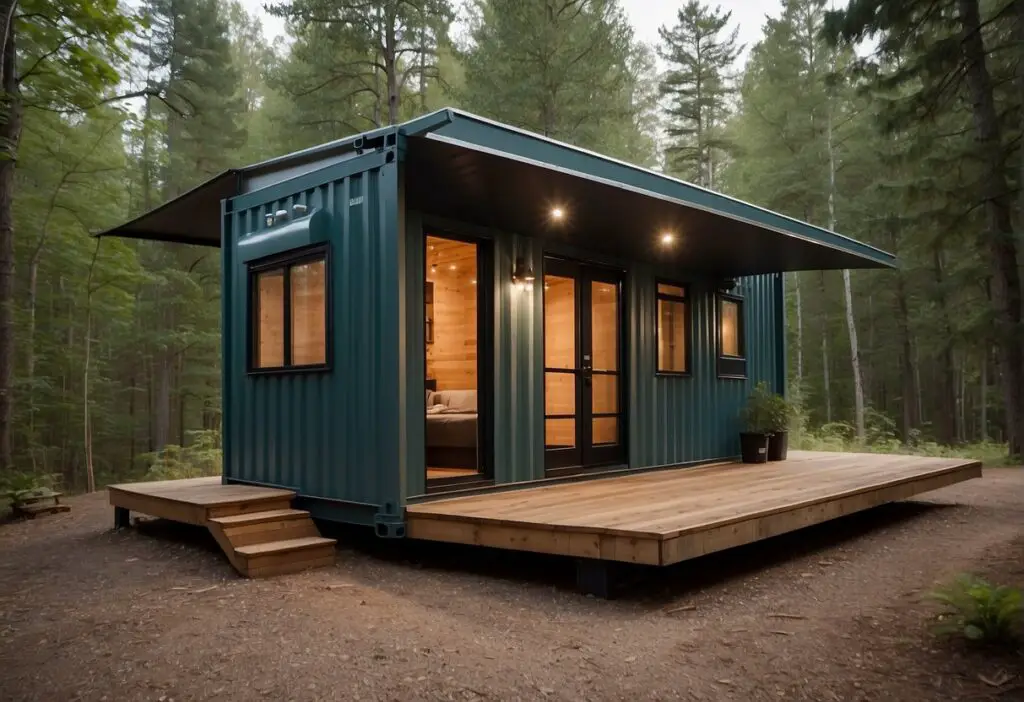
When constructing a shipping container cabin, there are three primary considerations to take into account: obtaining the necessary building permits, grasping the range of construction costs, and selecting materials that promote sustainability.
Securing Building Permits
Before acquiring shipping containers for construction, one must ensure compliance with local zoning laws and building codes by obtaining the appropriate building permits. This is not only a legal requirement but also a critical step in assessing the feasibility of the project. In some areas, shipping container homes may be subject to more flexible building rules, making the permit process more accessible.
Understanding Construction Costs
The financial aspect of constructing a shipping container cabin includes various expenses. Construction costs are influenced by the price of buying shipping containers, which can range between $1,500 and $5,000 depending on size and condition, with recycled shipping containers often presenting a cost-effective option. Additional expenditures comprise design, labor, foundation, insulation, and utilities.
- Container Costs: $1,500 – $5,000 (new or used)
- Labor: Varies significantly by region and scope
- Foundation: $5,000 – $15,000 on average
- Insulation: Can be a notable expense, considering climate needs
- Utilities Installation: Often similar to traditional home costs
Choosing Sustainable Materials
Sustainability is a crucial factor in the decision-making process. When constructing a shipping container cabin, one has the opportunity to use environmentally friendly materials. Utilizing recycled shipping containers is already a step towards eco-conscious construction. Beyond this, choices regarding insulation materials, interior finishes, and renewable energy sources further contribute to the cabin’s sustainability.
Customization and Features
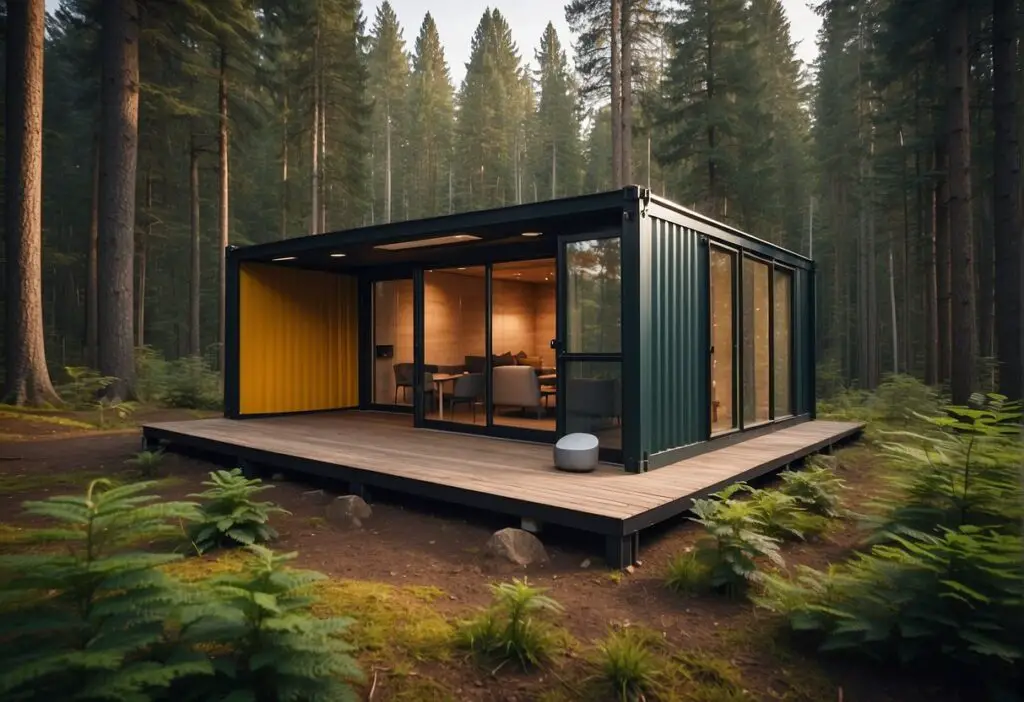
Shipping container cabins offer flexibility in design, allowing for a wide range of customization options to suit individual preferences and needs. They can include tailored interiors, functional exterior add-ons, and essential utilities and services.
Interior Customization
Doors and Windows: Customers may choose the number, style, and placement of doors and windows to enhance natural light and provide access. Options like sliding glass doors or large, double-hung windows can be included.
Kitchenette and Bathroom: A kitchenette can feature custom cabinetry, countertops, and appliances, while the bathroom can be designed with space-saving fixtures, incorporating modern plumbing solutions for comfort and convenience.
Exterior Add-Ons
Awnings: For added outdoor living space, awnings can be installed to create shaded areas, contributing to the cabin’s aesthetics and functionality.
Custom Build Add-Ons: Exterior add-on options may include decks, balconies, or rooftop terraces, expanding the living area and offering unique vantage points.
Utilities and Services
Electricity: Proper electrical wiring is essential for lighting, heating, and powering appliances, adhering to safety standards for residential dwellings.
Plumbing: Plumbing systems are designed for sustainability and efficiency, ensuring reliable water supply and waste management.
By selecting from a range of customization options, shipping container cabins can be transformed into personalized, feature-rich homes that reflect the owner’s lifestyle and preferences.
Logistical Aspects
In the context of shipping container cabins, logistical aspects encompass crucial considerations such as the transportation of the containers to the site and the methods of securing them upon arrival with foundations and anchorage. These factors are pivotal in the planning stages to ensure stability and alignment with site-specific requirements.
Transportation and Placement
Transporting a shipping container typically involves a combination of road transport and potentially other modes including rail or sea. The costs are influenced by the distance from the supplier to the destination, the size of the container, and the accessibility of the site. To place a shipping container on the site precisely, it may require a crane or other lifting equipment. The type of equipment needed often depends on the environment and the availability of space for maneuvering heavy machinery.
- Shipping Cost: Variable, depending on distance and transport method.
- Crane: Necessary for lifting and placement in constrained areas.
Anchoring and Foundation
Once on site, a shipping container cabin must be securely anchored to a foundation to ensure structural stability and resistance to extreme weather. Options for foundation systems include concrete slabs, piles, or piers, which are chosen based on soil type and the weight of the container. Piers can be a cost-effective and less intrusive option, which allows for elevated positioning:
- Piers: Generally less costly, facilitating drainage and reducing moisture-related issues.
Adherence to these logistical details in the initial stages paves the way for a smooth and successful build process.
Advantages of Shipping Container Cabins
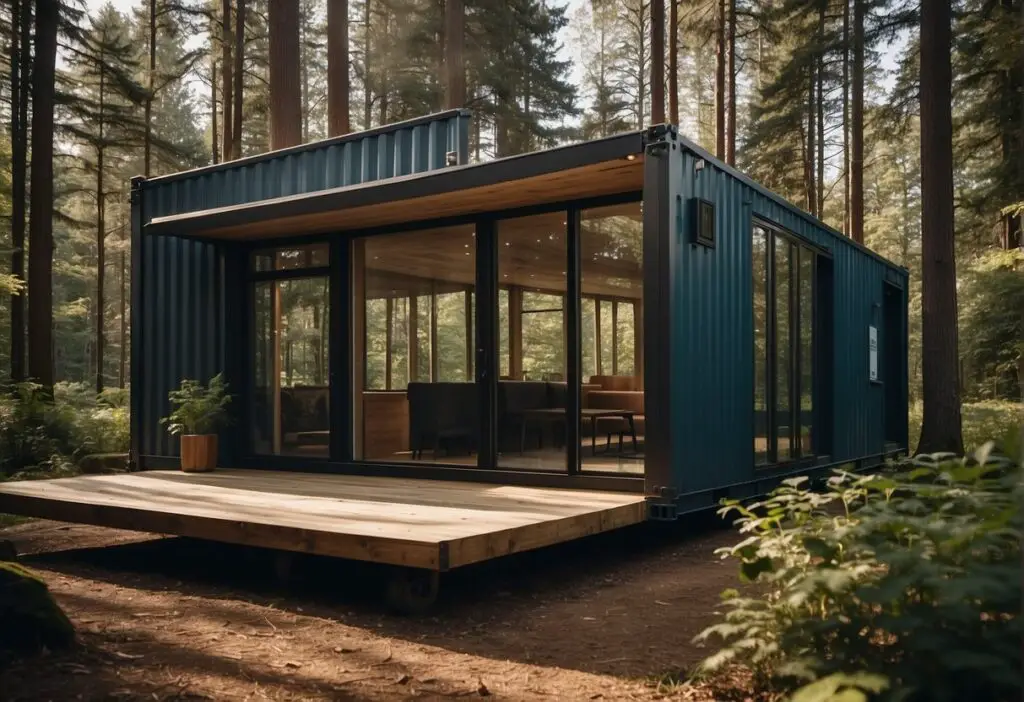
Shipping container cabins offer unique benefits that cater to cost-conscious individuals seeking durability and environmentally friendly options. These steel structures have gained popularity due to their inherent qualities, which align well with current sustainable living trends.
Affordability and Budgeting
Shipping container cabins present a cost-effective alternative to traditional building methods. The use of recycled shipping containers significantly reduces material costs, making the overall project more affordable. Prospective homeowners find that these cabins can offer substantial savings on their budget, especially when considering prefabricated options.
Durability and Security
Constructed from corrosion-resistant steel, these cabins boast considerable durability. They are designed to withstand harsh conditions during ocean transit, which translates into a robust and secure living space on land. Shipping container cabins can offer enhanced safety against environmental threats, such as extreme weather, when properly insulated and modified.
Efficiency and Eco-Friendliness
Shipping container cabins exemplify efficiency in both construction and energy use. They require less time to build than traditional homes and can be outfitted to utilize renewable energy sources. Furthermore, repurposing shipping containers as living spaces aligns with eco-friendly practices, reducing waste, and promoting the use of recycled materials.
Challenges and Solutions
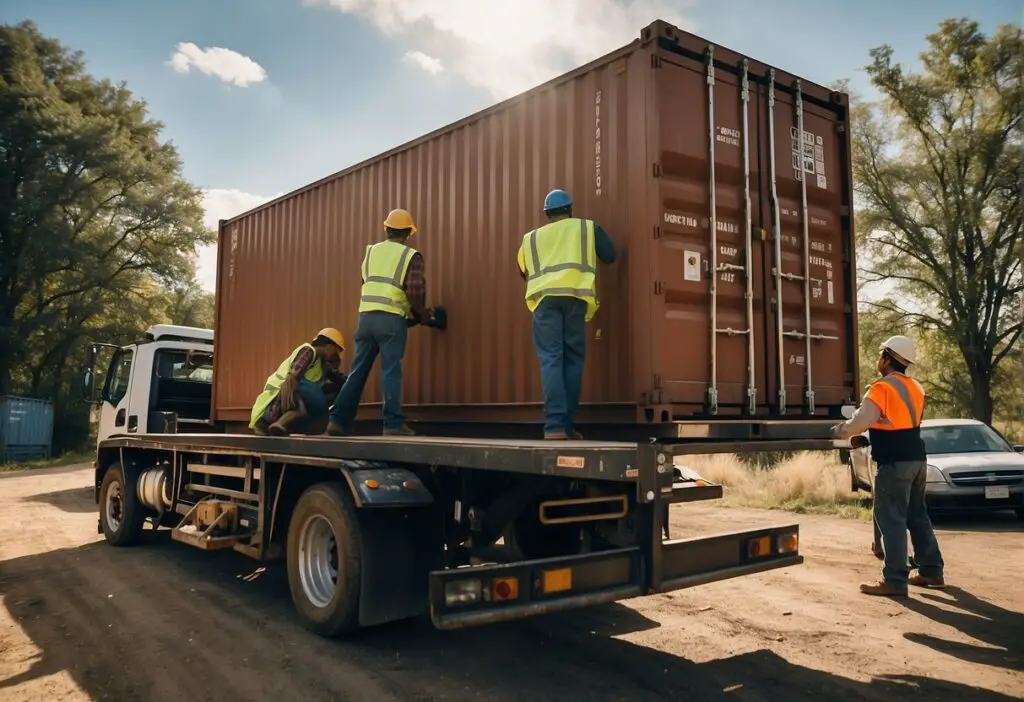
Transforming a shipping container into a habitable cabin involves several challenges that need to be systematically addressed to ensure a comfortable, functional, and durable living space.
Weatherproofing and Insulation
Shipping containers are made of steel, which is a good conductor of temperature, making it imperative to install high-quality insulation to maintain a cozy interior. Effective solutions include spray foam insulation that adheres to the container’s walls, creating a seamless barrier against heat and cold while also preventing moisture build-up.
- Materials: Spray foam, rigid foam, blanket insulation
- Benefits: Energy efficiency, prevents condensation
- Consideration: Balance between thickness and interior space
Space Maximization
Due to their narrow and long shape, containers present a challenge in utilizing space efficiently. A minimalistic design approach can be the key to maximizing the available area. Built-in furniture and multi-functional spaces are smart solutions that save space while providing the needed functionality.
- Strategies: Multi-use fixtures, vertical storage, collapsible elements
- Outcome: Clutter-free environment, enhanced usability
- Goal: To achieve a spacious feel within a compact footprint
Dealing with Pests
Pests, particularly mice, can find their way into the smallest of openings. Ensuring that a container cabin is properly sealed is essential. It involves inspecting and fortifying potential entry points and using materials that deter rodents.
- Methods: Steel wool, caulk, and metal flashing to seal gaps
- Regular Inspection: Doors, windows, vents, and utility openings
- Preventive Measures: Maintaining cleanliness to avoid attracting pests
By addressing these challenges with the right solutions, one can turn a shipping container into a comfortable and efficient cabin that stands the test of time.
Comparative Analysis
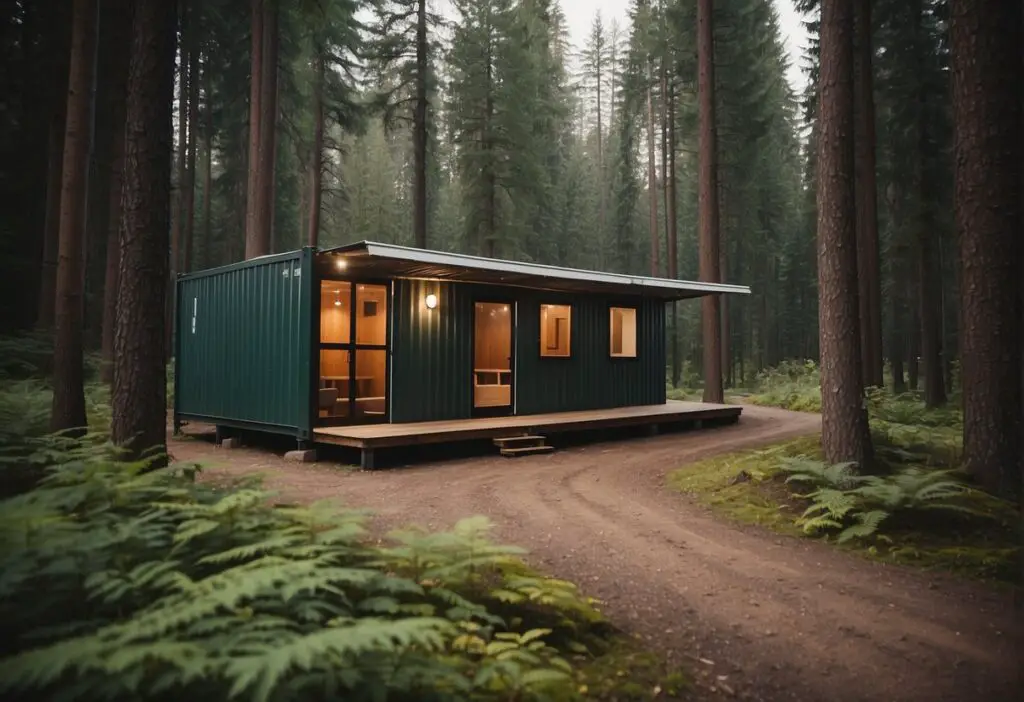
In this section, a detailed comparison between container cabins and traditional housing is presented, focusing on aspects such as cost and benefits. The analysis aims to provide clarity on how these innovative dwellings stand against more standard living options regarding affordability and value.
Container Cabins vs. Traditional Housing
Container cabins have gained attention as an affordable alternative to traditional housing. One can convert these steel structures, often regarded as surplus by shipping industries, into habitable spaces. On the contrary, traditional homes are typically built using materials like wood, brick, or stone. A key distinction lies in the adaptive reuse of material in container cabins, whereas traditional housing often relies on new resources, which can result in higher costs and environmental impact. Additionally, container cabins offer a unique modularity, allowing them to be easily transported and configured in various layouts, a flexibility that is not often found in traditional homes.
Cost-Benefit Analysis
When assessing the financial aspects, container cabins often present a lower initial price point than traditional homes. However, there can be additional costs related to insulation, interior finishes, and site preparation that may narrow the cost gap. Below is a simplified cost comparison:
| Cost Factor | Container Cabins | Traditional Housing |
|---|---|---|
| Initial Purchase | Often cheaper; price varies based on size and condition | Higher; influenced by location, materials, and size |
| Renovation & Finishing | Can be cost-effective depending on materials | Varies widely; luxury finishes drastically increase the price |
| Long-term Value | Dependent on the quality of the conversion and upkeep | Generally appreciates; seen as a long-term investment |
Despite the enticing price of shipping container cabins, they must adhere to local building codes and regulations, which can affect the total investment. The appeal of container cabins often rests upon their cost-efficiency and sustainability; they serve as a testament to the creativity and ingenuity in modern housing. Conversely, traditional homes remain a staple in the housing market, offering stability and a widely accepted form of investment.
Case Studies and Examples
In the realm of alternative housing, shipping container cabins stand out for their versatility and eco-friendliness. This section examines specific examples that showcase the innovation and creativity inherent to this unique style of home.
The PORTER by Bob’s Containers
“THE PORTER” is a testament to the adaptability of shipping containers into living spaces. Bob’s Containers has transformed a conventional container into a compact, functional abode that suits the needs of individuals aiming for a minimalist lifestyle. Stylistically, it mirrors a studio apartment, offering all necessities within a cozy space. ( STARTING AT $141,041 )
The PIONEER by Custom Container Living
Crafted with meticulous attention to detail, THE PIONEER by Custom Container Living exemplifies a harmonious blend of comfort and practicality. It is a shipping container cabin that expands on the basic concept by integrating multiple containers to provide a more spacious environment, making it ideal for families or remote workers in need of extra room. ( STARTING AT $98,900 )
The GS-215 by Ballance Containers
Ballance Containers presents The GS-215, a shipping container cabin that is both innovative and environmentally conscious. It showcases how a simple structure can be elevated to a sophisticated abode, suitable for those seeking a refuge in nature without leaving behind modern comforts. ( STARTING AT $95,000 )
While not highlighted in the above examples, other notable models in the shipping container cabin industry include the Studio 320 by Hybrid, a model recognized for its sleek design and efficient use of space, the Tin Can Container Cabin, which radiates rustic charm with a modern twist, and the Canadian Container Cabin, a dwelling that encapsulates the rugged beauty of its national heritage while offering a sustainable housing solution.
Final Thoughts
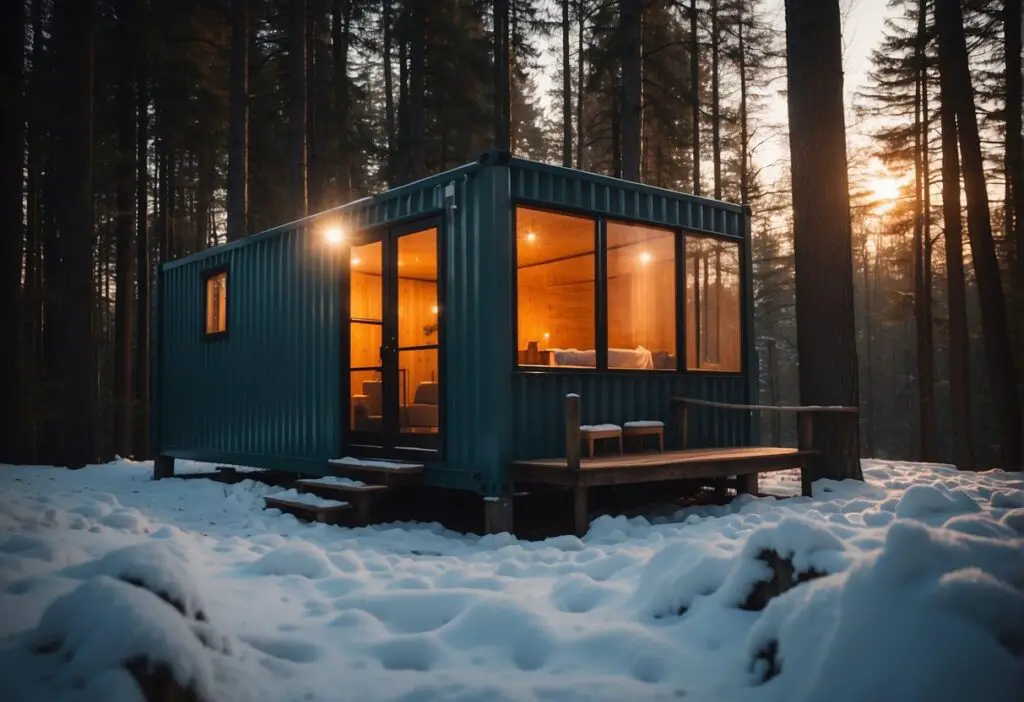
The concept of utilizing shipping containers for building cabins offers a plethora of benefits—both functional and aesthetic. Whether one aspires to possess a modern cabin that exemplifies a minimalist charm or a more rugged hunting cabin, these steel structures provide a robust foundation that can endure the harshest environments.
For the outdoor enthusiast, a hunt camp container presents a unique blend of durability and convenience. These cabins can often be transported to remote locations and secured swiftly, making them an ideal choice for hunting camps. The adaptability of the shipping container allows customization to meet the specific needs of any retreat.
In terms of sustainability, these cabins score highly. Given their origin as recycled materials, they often align with eco-friendly construction practices. Builders can further enhance this characteristic by incorporating green technology.
List of Key Attributes:
- Sustainability: Eco-friendly due to recycling potential.
- Durability: Steel construction offers robustness.
- Customization: Adaptable to various styles and necessities.
- Transportability: Ideal for remote locations.
It is worth noting that careful planning is crucial to maximize the potential of a shipping container cabin. Consideration of insulation, ventilation, and interior design will ensure the transformation from a cold, corrugated steel box to a cozy and inviting space.
Shipping container cabins, whether fashioned into a sleek modern cabin or purposed as a the hunt camp container, are making a significant impact in the realm of alternative housing. They effectively intersect innovation with practicality, serving as a testament to human ingenuity in the face of modern challenges.
